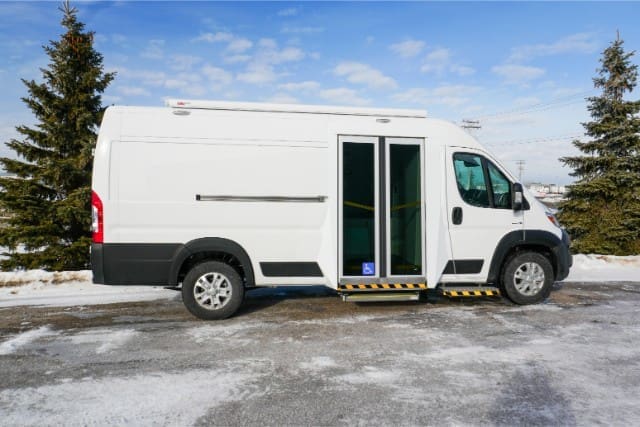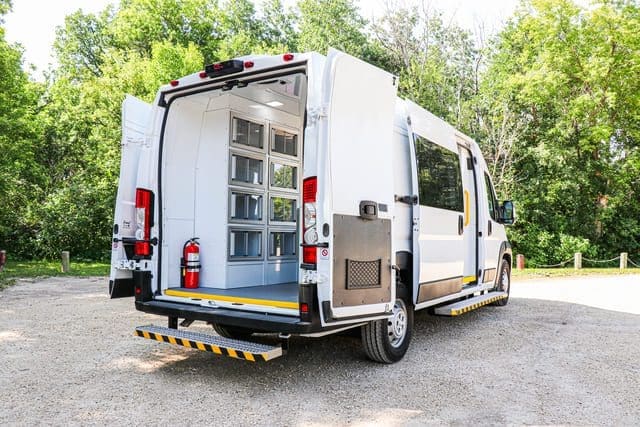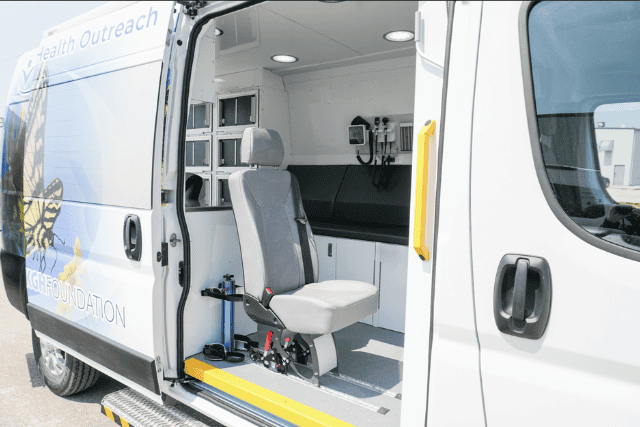Is your organization currently in the process of researching different mobile medical units for your rural healthcare program? The wrong mobile medical unit can affect the type of medical services you provide, hinder your ability to serve specific areas, and result in higher maintenance and repair costs.
Our team at AVAN Mobility manufactures mobile medical units for organizations providing mobile healthcare to underserved people across the U.S. We’ve been in this industry for over 10 years, and we want our customers to make educated decisions about their mobile medical programs.
By the end of this article, you’ll have an unbiased look at some of the mobile medical units ideal for rural mobile healthcare in America. Let’s start by looking at some features that mobile medical units should have when bringing their services to rural regions of the country.
What features do a mobile medical unit need for rural healthcare?
Providing healthcare in rural areas of the United States can be quite challenging due to distance and rugged terrain. Mobile medical units are a crucial solution. Let’s explore why these key features are important in mobile medical units for rural healthcare.
1. “Doctor’s office on wheels” setup

Why it’s important: These mobile units should function like a doctor’s office on wheels, offering comprehensive care. This approach ensures that patients in remote areas receive thorough examinations, diagnoses, and treatment similar to what they’d get in a traditional medical setting.
2. Floor-to-ceiling cabinetry
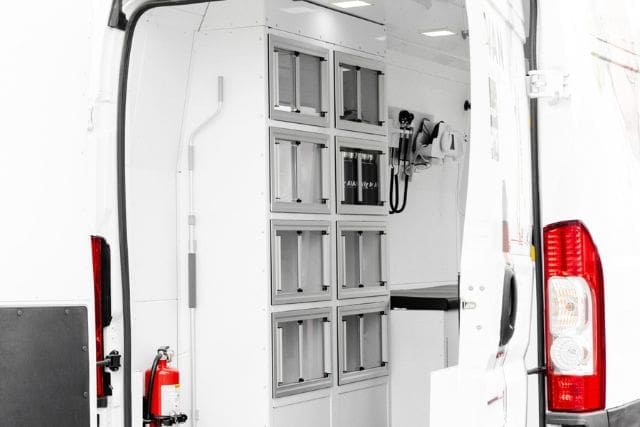
Why it’s important: Rural regions don’t have easy access to medical supplies. Having lots of storage space on board means medical equipment, medications, and supplies are close at hand. This organization is vital for efficient and effective healthcare delivery.
3. Patient bed with under-bed storage

Why it’s important: Providing a comfortable patient bed with under-bed storage means they can rest and keep essential items within reach, enhancing their comfort and convenience during examinations and treatments.
4. Options for sink and fridge

Why it’s important: Proper hygiene and medication storage are important in healthcare. A sink enables medical staff to maintain hand hygiene, while a fridge keeps medications at the right temperature. These features are necessary for safe and high-quality care.
5. Power supply

Why it’s important: Rural areas sometimes experience power outages or lack reliable power sources. An uninterrupted power supply, provided through backup generators or solar panels, ensures that medical equipment functions correctly, allowing consistent care, regardless of location.
6. Rear heat & air conditioning
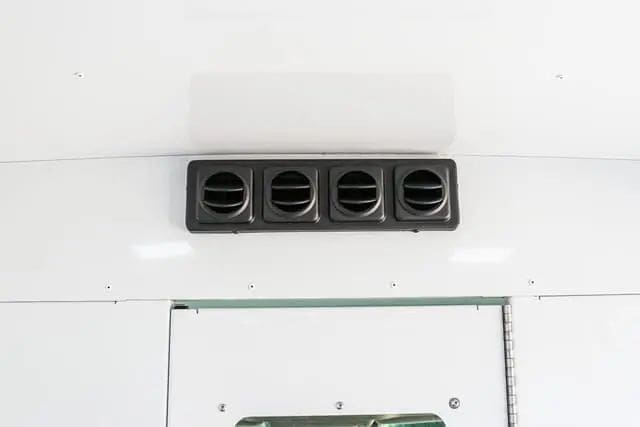
Why it’s important: Weather conditions in rural areas can be extreme. Rear heat and air conditioning systems create a comfortable environment for patients and medical staff, ensuring healthcare services can be provided in any season.
7. Clean, comfortable environment
Why it’s important: A clean and comfortable environment is required for patient well-being. It reduces the stress and anxiety associated with medical visits, contributing to a positive patient experience, and enhancing overall healthcare access and quality.
8. Short wheelbase
Why it’s important: The wheelbase on a mobile medical unit is the distance between the center of the front wheels and the center of the rear wheels. A short wheelbase on a mobile medical unit means that the distance between the front and rear axles of the vehicle is relatively small.
In rural areas, shorter wheelbases are more advantageous than longer ones. They navigate rural roads more effectively due to their increased maneuverability. Rural roads can be narrow, winding, and uneven, making it challenging for longer units to traverse them.
Shorter wheelbases can easily negotiate tight turns and tackle rough terrain, ensuring that healthcare services can reach even the most remote locations. This improves access to healthcare in rural areas, where longer units may struggle to provide the same level of care.
Some of the rural regions of the U.S. where a mobile medical unit with a shorter wheelbase comes in handy are:
Appalachian region: The hilly and mountainous terrain requires vehicles that can handle steep slopes and tight turns.
Midwest farmlands: Narrow and unpaved roads are common in the farmlands, making maneuverability a key factor.
Desert Southwest: The arid landscape may have challenging access points that shorter units can reach effectively.
Here is a quick look at some of the areas in the U.S. states where a mobile medical unit with a shorter wheelbase would be beneficial:
| Region | States in the region |
| Appalachian Region | West Virginia, Virginia, North Carolina, Kentucky, Tennessee, South Carolina, Georgia, Alabama, Mississippi, Ohio, Pennsylvania, Maryland, and New York. |
| Midwest Farmlands | Illinois, Indiana, Iowa, Kansas, Michigan, Minnesota, Missouri, Nebraska, North Dakota, Ohio, South Dakota, and Wisconsin. |
| Desert Southwest | Arizona, New Mexico, Nevada, and Utah. |
9. Customization options
Why it’s important: Rural healthcare needs vary from one region to another. Customization allows your mobile medical unit to be equipped with the right medical equipment for the right population and areas. It makes sure that the mobile units are optimized for their intended purposes.
Mobile Medical unit: Which are the top 5 for rural healthcare?

There are a variety of different mobile medical units available to choose from. Some stand out from the rest when it comes to providing adequate healthcare in rural areas. Keep in mind that information regarding these mobile medical units is based on information made publicly available online.
1. Summit Bodyworks – 2022 Ford Transit 350 HD
The Summit Bodyworks 2022 Ford Transit 350 HD is great in rural areas. It has a 148″ wheelbase and a strong Gross Vehicle Weight Rating (GVWR) of 10,360 lbs. This makes it stable and durable on tough terrains. Remote areas can stay connected with the 4G LTE Cradlepoint Dual Modem Dual Antenna.
In addition, it has an electric awning. It also has a gas generator. The inverter package includes lithium-ion batteries. This provides continuous power in places where it’s usually limited.
This unit prioritizes patient comfort and safety. The rooftop air conditioner ensures a pleasant interior environment. There are two screening areas that efficiently accommodate patient needs. The sliding door makes it easy to enter. It’s equipped with essential medical equipment, optimizing rural healthcare delivery. The sharps disposal container is a top priority to keep safety in mind. Additionally, overhead storage and rear swing-out doors add practicality.
The Summit Bodyworks unit has a one-year limited warranty and unlimited miles, which gives rural healthcare providers peace of mind. You can customize the graphics on your unit to match your branding, which will make it easy to recognize in rural communities.
2. La Boit – 22FT Medical Sprinter Van
The La Boit 22FT Medical Sprinter Van is a rural healthcare gem, designed to excel in the remote areas of the U.S.
The van has a 12V system and a 2000-watt Inverter/Charger for electricity. It works even in remote areas. The A/C and rear heat are both powered by the engine and guarantee patient comfort in extreme rural weather conditions.
The water supply includes a 15-gallon tank for freshwater. It also includes a 13-gallon tank for gray water and a 2.5-gallon hot water heater. It efficiently meets the needs of rural healthcare practitioners.
La Boit’s custom-made cabinets are designed for safety and organization. They have stacking storage functionality and a locked drawer for medical supplies. The full window privacy glass package ensures patient confidentiality. In rural settings, safety features are essential. These include an entrance grab handle, fire extinguisher, smoke/carbon monoxide detector, and a pharmaceutical lock drawer.
The Mercedes Sprinter Van has a reliable 3.0 Turbo Diesel Blue TEC engine and automatic transmission. The 360-degree camera, blind spot assist, and attention assist make driving safer in rural areas.
3. Specialty Vehicle Exchange – 25FT Two-Room Mobile Medical Unit Clinic
The Specialty Vehicle Exchange Ford E-450 is a great option for rural healthcare in the U.S. It’s a mid-sized unit that maximizes efficiency with two entry points.
This vehicle’s ease of use and essential features make it ideal for rural healthcare. It comes with an exam table, a medical-grade fridge, a bathroom, and custom cabinetry. These features are crucial for rural healthcare providers who need to offer comprehensive care to patients in remote regions.
Safety is a priority with the full roll cage, ensuring protection on challenging rural roads. The roomy straight wall exterior design also makes it adaptable for various healthcare missions.
The Ford E-450’s 7.3L V8 Gas Engine, 14,500 GVWR, and 6-speed automatic transmission provide reliability, especially when navigating rural terrains.
It’s not just about the vehicle’s design but also about its safety and versatility. In rural areas where healthcare access can be limited, the Ford E-450 in this mobile clinic stands out as a dependable and well-equipped solution, designed to help healthcare providers deliver quality care where it’s needed most.
4. CGS Premier – Customizable Mobile Medical Unit – Sprinter Van
The Customizable Medical Sprinter Van from CGS Premier is the ideal solution for rural areas in the U.S. These vans offer numerous benefits that are especially valuable in remote regions.
In rural areas with few healthcare facilities, this van provides a lifeline for people. It provides medical care to those without easy access to clinics because of limited transportation.
The van can be customized to fit the specific needs of healthcare providers. The van can be designed to fit essential equipment and staff for exams, lab work, or testing.
This mobile clinic makes building good relationships easier for doctors and patients. This trust helps patients follow treatment plans, which leads to better health outcomes.
The van’s interior can be customized, so it is easy to keep it clean and organized. This efficiency increases the number of patients seen in a day. You can put your logo and branding on the van. This way, people will easily remember it as part of your healthcare services.
5. Magnum Mobile – 19FT Mobile Medical Unit
The Magnum Mobile 19FT Mobile Medical Unit has a GVWR of only 9,500 and is the last one that stands out on the list. Its compact size and easy maneuverability make it perfect for rural areas. Healthcare providers can reach remote communities that larger units might struggle to access.
The unit is equipped with essential features for patient care. It has an exam table and seating for healthcare professionals. In places with extreme weather, the single A/C unit with a heat pump keeps things comfortable.
The swing door is 30″ and has a window and deadbolt for security. The backup camera helps with safe navigation. Inside, four interior LED lights illuminate the workspace.
The unit can work alone with a 4,000-watt gas generator, extra battery, and charger. It’s great for areas with limited power supply.
The cabinets and walls are laminated for durability and easy cleaning. The folding aluminum portable step makes entry easier. An additional LED in the porta-potty enhances safety and convenience.
The 19FT Mobile Medical Unit is a small, flexible, and well-equipped solution for rural areas with limited healthcare access. It provides important medical services to faraway communities so everyone can get healthcare.
Final thoughts
As you can see, the majority of the mobile medical units on this list have a shorter wheelbase. That’s because rural areas often feature narrow roads and tight spaces. Shorter units are easier to navigate, ensuring healthcare providers on your team can reach remote locations with less hassle.
Shorter units are also more fuel-efficient and cost-effective in the long run. They have faster setup times, and this is important in emergency situations. They’re also easier to park in small, rural communities. This is important to help foster closer connections with the location population.
The road ahead with AVAN Mobility

You came to this article looking for more information on some of the mobile medical units available for rural healthcare.
You learned about five suitable options to get you started in the right direction. Now that you’ve digested the insights in this article, remember that at AVAN Mobility, we’ve already implemented the very features in our vans that we discussed earlier.
Our 159″ wheelbase is tailor-made to be perfect for both rural and urban healthcare settings, and our mobile medical units are not just equipped with but loaded with all the essential features we’ve explored here. When you choose AVAN Mobility, you’re not just choosing theory; you’re choosing practical, real-world solutions for delivering quality healthcare in even the most remote locations.
As your organization is gearing up to invest in a mobile medical unit, you’re probably curious about how to apply for and secure grants. Read these two articles to give you more insight into getting the grant funding you need for your mobile medical unit.
- A Guide on Securing Grants for Mobile Health Clinics in the U.S.
- Top 6 Ways to for Apply Mobile Health Grants
If you have any questions or want to learn about some of our mobile medical units at AVAN Mobility, feel free to click the button below to reach out to a mobility expert.


